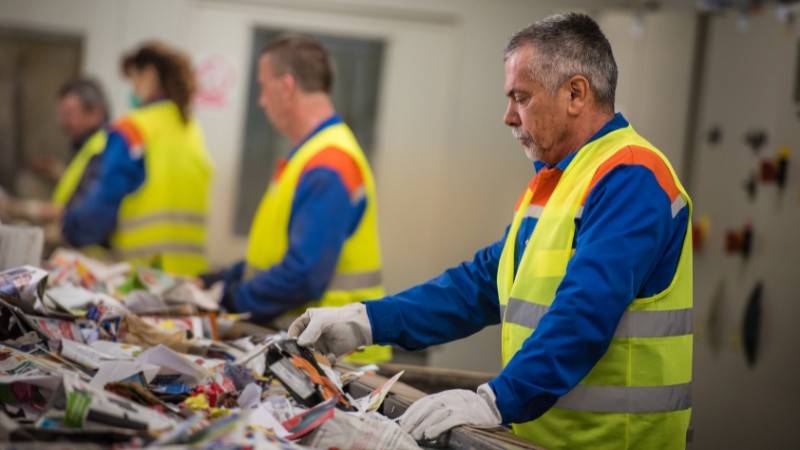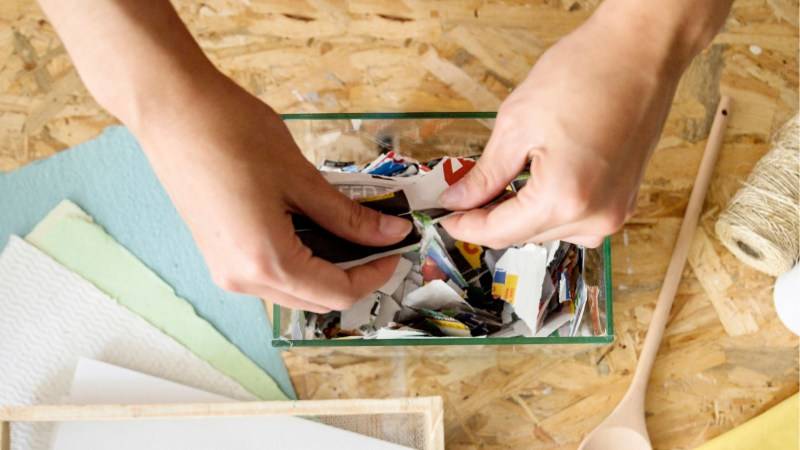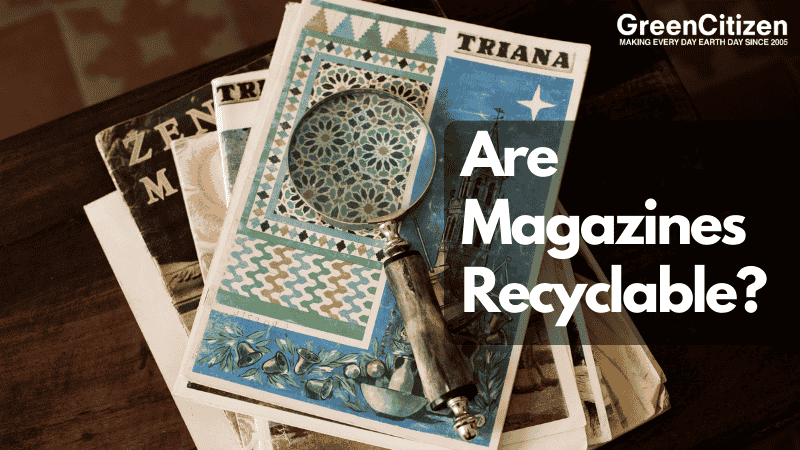You know, when I sit back with a cup of coffee and flip through the glossy pages of a magazine, I can’t help but wonder about their end life. With magazines being so ingrained in our daily lives, the question “are magazines recyclable” often pops into my mind.
You’d be surprised to know that the top 25 magazine publications boast a staggering circulation of over 25 million!
That’s a lot of magazine pages potentially heading to landfills.
But here we are, my friends, constantly diving deep into the vast ocean of recycling and sustainability. You and I are not just about making our homes greener, but also about understanding the intricacies of what can and can’t find its way back into the cycle.
So, what about those old magazines piling up on your coffee table? Is there a sustainable way to give them a new life?
In this blog, I’m going to delve into whether magazines are recyclable, why magazine pages might be different from other paper, and how you can responsibly recycle magazines.
Stick with me, and we’ll navigate this together.
Can You Recycle Magazines?
So, diving straight into the heart of our topic: Can we recycle magazines?
The answer is, largely, yes! Most old magazines can certainly find their way back into the loop. However, there’s a tiny hitch. If a magazine is coated with polyethylene (PE) materials, it might not be so welcome in your recycling bin.
Let me shed a bit more light on this. A majority of print magazines use a glossy coating to give them that lustrous, appealing finish. This glossy allure often comes from clay and other minerals applied to the magazine paper.
Now, this kind of glossy paper is generally recyclable.
But, as I mentioned, if PE materials (a type of plastic) are involved, recycling becomes a challenge. The reason? These PE-coated magazines can’t be processed the same way as our typical recycled magazine paper at most recycling centers.

When you’re about to recycle magazines, it’s important to understand what you’re tossing into the recycling bin. Because, while many of us might reuse magazines for craft or art projects, ensuring they’re appropriately recycled when their time is up remains vital.
Always check the magazine for recycling indications or consider dropping them off at a dedicated recycling center, especially if you’re unsure about their glossy finish.
The Basics of Magazine Recycling
Diving a bit deeper into our recycling journey, it’s crucial to grasp the basic elements that constitute our beloved magazines.
So, let’s unwrap the mystery behind those glossy pages.
What Materials Are Magazines Made Of?
Magazines, at their core, are primarily composed of paper. Yet, this isn’t just any ordinary paper.
Embedded within are inks that give life to those captivating images and gripping text. Then there’s the glossy or coated paper finish that provides that sheen we all appreciate.
But here’s a tidbit: Did you know some magazines might contain a thin layer of plastic called polyethylene to enhance that gloss?
It’s these added elements that can sometimes make unwanted magazines a bit of a puzzle when considering where to toss them – the recycle bin or elsewhere.
How Are Magazine Pages Different from Regular Paper?

Alright, my eco-savvy friend, think about it this way: You wouldn’t use paper towels to jot down your grocery list, would you?
Similarly, the paper used in magazines isn’t your standard sheet from the local library. The presence of coatings, particularly the glossy paper finish, sets them apart.
This coated paper is designed to offer vibrant print quality. Additionally, the type of ink used for magazines is often different from, say, your daily newspaper, primarily because it needs to adhere well to those sleek, coated pages.
This intricacy means that while recycling, paper fibers from magazines might need a tad different treatment at the recycling plant compared to other paper products.
If your stack of old magazines is still growing, why not consider using them for craft projects? Or better yet, donate them to a local library or school before considering the recycling center.
How to Recycle Magazines
As we journey deeper into our recycling quest, knowing the practicalities becomes essential. So, if you’ve been collecting those old magazines and now wonder how to get them recycled, you’re in the right spot. Here’s a guide to get you started.
Preparing Magazines at Home
Before you toss your magazines into the blue bin or take them to a recycling facility, a bit of prep goes a long way to ensure smooth recycling.
Let’s check the steps you should be aware of:
- Review Your Magazines: Skim through your magazines to check for any non-paper elements. Plastic inserts or cards must be removed as they can’t be recycled alongside magazine paper.
- Clean and Dry: Ensure your magazines are free from dampness or contaminants. Wet or soiled magazines may not be ideal for recycling.
- Stack Them Together: Group your old magazines together using a rubber band or in a paper bag. This makes it easier for recyclers to handle and process them.
- Check For Specialty Magazines: Some magazines might be designed with unique elements, such as metallic foils. Such specialty magazines may need different recycling methods.
- De-inking: While this isn’t a process you’d carry out at home, be aware that most magazines will be de-inked at the recycling center. This process removes the ink from the magazine paper before it’s recycled.
Finding Local Recycling Facilities
The heart of our recycling mission lies in the facilities that turn our old materials into something new. If you’re in the USA, you’re in luck. The Green Directory from GreenCitizen has revolutionized the way we locate recycling centers.

This directory is a fantastic tool that lists recycling facilities tailored to specific items. So, if you’ve got an old magazine or any other item to recycle, simply enter it into the Green Directory, and voila!
You’ll find the nearest recycling centers that accept that particular item.
Beyond magazines, the Green Directory is an all-encompassing platform. It provides users with information on facilities that handle everything from electronics to furniture. The mission of GreenCitizen’s Green Directory is clear: making recycling accessible and straightforward for everyone in the USA.
Why Is Recycling Magazines Important?
As we’ve meandered through the world of magazine recycling, you might wonder, why all the fuss? Well, understanding the bigger picture behind recycling magazines gives us a clearer sense of our collective mission. Let’s dive into the reasons.
The Impact of Magazines on the Environment
Ever stopped to think about the journey of a single magazine before it reaches your hands? It’s quite a saga. The process begins with the sourcing of raw materials, primarily trees, which involves significant deforestation. This, in turn, disrupts habitats and affects biodiversity.
Next comes the production phase, which uses energy and water while emitting greenhouse gases. The printing inks, while bringing our favorite content to life, also introduce chemicals into the environment.
Distribution isn’t free from environmental costs either. Think about the fuel used in transporting countless magazines worldwide, leading to more emissions. Finally, if not recycled, they become waste, adding to an already burgeoning environmental issue.
Landfills and the Magazine Glut
Now, let’s envision a situation. Each one of those unread or discarded magazines we casually toss away ends up in landfills. With millions of magazines published every year, that’s a monumental pile, isn’t it?
In landfills, these magazines don’t just rest in peace. They undergo slow decomposition, releasing methane—a greenhouse gas far more potent than carbon dioxide. Moreover, the inks and chemicals from the magazines can leach into the ground, contaminating soil and water sources. The domino effect continues as this can harm plants, animals, and even our water supply.
So, each magazine we recycle is a step away from these adverse effects. It’s a stride towards a healthier planet and a brighter future for all its inhabitants.

Read More:
How to Repurpose or Reuse Old Magazines
Before resigning old magazines to the blue bin, have you ever paused to think about the myriad of ways they could be repurposed? Giving our reading material a second life not only reduces waste but sparks creativity. Here’s a nifty guide to get those creative juices flowing.
DIY and Craft Projects
For those crafty souls, magazines are a goldmine. With vibrant images and colorful pages, they offer a palette of paper products that can be transformed into art.

- Wall Art: Create a mosaic or collage using magazine pages. Cut, arrange, and paste to form patterns or images, then frame it for a unique piece of art.
- Origami: Magazine pages are perfect for origami crafts. From birds to boxes, their colorful pages give an added aesthetic to the creations.
- Coasters: Using cardboard as a base, layer and roll magazine pages tightly to craft a unique set of coasters.
- Beads for Jewelry: Roll pages to create beads, seal with a clear coat, and string them together for necklaces or bracelets.
- Egg Cartons: Believe it or not, with a bit of DIY spirit, you can convert old magazines into homemade egg cartons. Perfect for those backyard poultry enthusiasts!
Use as Creative Wraps
We’re in an era where almost everything we buy is wrapped in plastic. But why not revert to paper? Magazine pages, especially those with vibrant images or patterns, can be used as unique gift wraps, adding a personal touch to your presents. Plus, it’s an eco-friendly alternative to printed plastic wraps.
Donating and Swapping
Instead of relegating old magazines to trash, consider donating them. Schools often require reading material for projects.
Thrift stores or community centers might also welcome such donations.
Moreover, swapping magazines with friends or neighbors is a great way to share content and discover new articles or trends you might have missed. Remember, in most cases, one person’s discard can be another’s treasure.
Magazine-based Cat Litter
This might surprise you, but shredded magazines can be an alternative to commercial cat litter. When combined with certain materials like wood fiber, shredded magazine pages absorb moisture and help neutralize odors.
So, if you’re seeking sustainable solutions in almost every aspect of your life, here’s one for your feline friend.
Is Magazine Paper Compostable?
The sustainability journey doesn’t end with recycling. The realm of composting beckons with another question: Can we compost our magazines?
First things first, magazines can indeed be added to your compost pile, but with a caveat. Magazines that are coated with polyethylene (PE) materials aren’t suitable for composting. PE-coated magazines don’t break down easily, making them a poor fit for your compost bin.
However, if you’ve checked and found your magazines free of this plastic coating, there’s a green light. To speed up the composting process, shred the magazine pages first. This increases their surface area, allowing microbes to break them down faster.

Now, let’s talk about the glossy paper. There’s been hesitancy in composting glossy paper due to concerns over toxic inks harming the soil and its tiny inhabitants. However, the sustainability wave has transformed the printing industry as well. The once prevalent petroleum-based inks, notorious for their environmental harm, have now largely been replaced by eco-friendlier, compostable alternatives like soy ink.
If you’re wondering how to ascertain if your magazine uses compost-friendly ink, look out for the SoySeal. It’s the American Soybean Association’s official certification, ensuring the ink’s compostability and safety for the environment.
To sum it up, with a few checks and preparations, your magazine can return to the earth, enriching it rather than burdening it.
Frequently Asked Questions (FAQ)
Yes, most glossy magazines can be put in the recycle bin. However, ensure they aren’t coated with non-recyclable materials like polyethylene (PE).
Old magazines can be recycled, composted (if they use eco-friendly inks), repurposed into DIY projects, or donated to schools and thrift stores.
Instead of discarding them in the trash, it’s better to recycle, repurpose, or donate old magazines to reduce waste and environmental impact.
Magazines should be placed in the paper or mixed recycling bin, depending on your local recycling guidelines.
Conclusion
As we turn the last page on our deep dive into magazine recycling, it’s evident that these often glossy, colorful publications hold significant weight in our journey towards a more sustainable future. Their presence in our lives, from waiting rooms to coffee tables, comes with an environmental responsibility that we all share.
Magazine recycling isn’t just about clearing out clutter or ensuring our recycle bins are full; it’s a step towards reducing waste, minimizing our carbon footprint, and giving these pages a second life in another form, whether that’s as a recycled product or a heartwarming craft project. By composting, repurposing, and recycling, we can make an impactful statement against the ever-growing landfill crisis.
But as with all meaningful journeys, the more, the merrier. By sharing this article and the insights within, you can help spread awareness, encouraging more people to make eco-friendly decisions. Every recycled magazine, every shared post, and every conversation adds up, driving us closer to a greener tomorrow.

